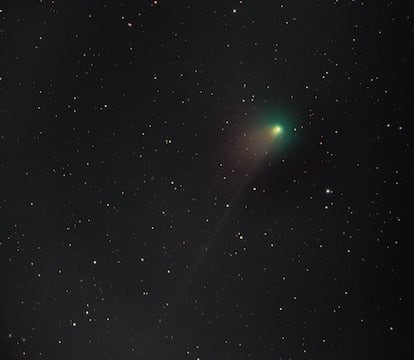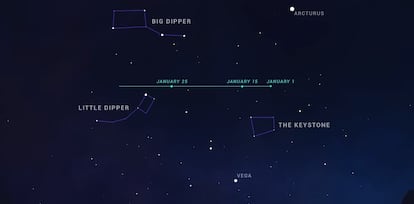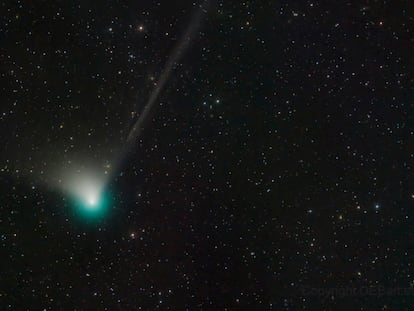Green comet with an ethereal third tail approaches Earth
With its peculiar optical illusion, this visitor from outer space can be better appreciated with binoculars or a telescope and away from light pollution

The last time this green comet was visible from Earth was 50,000 years ago when Neanderthals were still living in Europe. It is bright green and has an antitail – an ethereal third tail which appears to streak in the wrong direction due to an optical illusion, apparently breaking the rules of physics.
Almost perceptible to the naked eye, its antitail and color make it something of a phenomenon. “It’s over-hyped because nowadays everything is, but the truth is that it’s cool,” says Javier Armentia, astrophysicist and director of the Pamplona Planetarium. “Not all comets have this antitail, or rather, normally the phenomenon of material leaving the comet is not observable; also, the green color, although not unusual, is striking,” he says.
The comet was discovered in March 2022, less than a year ago, by the Zwicky Transient Facility (ZTF), from which it derives its actual scientific name: C/2022 E3 (ZTF).
Why is it green? This is not the first time a green comet has been visible from Earth; there are others such as the one spotted by NASA in 2009. The green color occurs only in the turquoise aura around its head, which is caused by the reaction of ultraviolet light and a carbonaceous gas emanating from it, as described in a 2021 study that tried to explain the phenomenon.
What’s the antitail? The antitail on this comet makes it rare, though not unique. The famous 1997 Hale-Bopp had one. The twin tails of a comet are often clearly visible, thanks to the fact that the dust trail reflects the sunlight and the gas inside the other tail is ionized, giving it a faint glow. But the third tail – the antitail – seems to be going in the opposite direction from what you might expect: it’s an optical illusion seen when the Earth crosses a comet’s orbital plane. “At that moment, the edge of the comet’s fan-shaped dust tail looks like a spike pointing toward the sun,” according to SpaceWeather.

Can the comet be seen with the naked eye? It’s unlikely if you’re walking through the center of a city. Ideally, it should be observed away from light pollution and in a rural area. “It’s tiny, and although people might try to convince you that they can see it without binoculars or a telescope, there’s no way,” says Armentia, adding, “The Moon is rising and in the next few days there will be more light in the sky and less contrast.”
“It will pass close to the Pole star on January 30 and near the bright Capella on February 6, moving at a very high angular velocity leading up to the days when it is closest to Earth,” says astrophysicist Josep Maria Trigo in The Conversation.
According to NASA, it should be visible with a telescope and probably binoculars. Observers in the northern hemisphere can see the comet in the sky before dawn in January, as it moves rapidly northwestward. And it will become visible in the southern hemisphere in early February. Next week will be the ideal week to observe it. “This comet is not expected to be the spectacle that Comet NEOWISE was in 2020, but it is still an incredible opportunity to make a personal connection with an icy visitor from the distant outer solar system,” NASA notes.
How close does it get to us? February 1 will be when it comes closest to Earth. The comet reached its perihelion – the point at which it is closest to the sun – on January 12, at a distance of 166 million kilometers, while the closest approach to our planet will be at a distance of just 42 million kilometers on February 1.
Sign up for our weekly newsletter to get more English-language news coverage from EL PAÍS USA Edition
Tu suscripción se está usando en otro dispositivo
¿Quieres añadir otro usuario a tu suscripción?
Si continúas leyendo en este dispositivo, no se podrá leer en el otro.
FlechaTu suscripción se está usando en otro dispositivo y solo puedes acceder a EL PAÍS desde un dispositivo a la vez.
Si quieres compartir tu cuenta, cambia tu suscripción a la modalidad Premium, así podrás añadir otro usuario. Cada uno accederá con su propia cuenta de email, lo que os permitirá personalizar vuestra experiencia en EL PAÍS.
¿Tienes una suscripción de empresa? Accede aquí para contratar más cuentas.
En el caso de no saber quién está usando tu cuenta, te recomendamos cambiar tu contraseña aquí.
Si decides continuar compartiendo tu cuenta, este mensaje se mostrará en tu dispositivo y en el de la otra persona que está usando tu cuenta de forma indefinida, afectando a tu experiencia de lectura. Puedes consultar aquí los términos y condiciones de la suscripción digital.











































